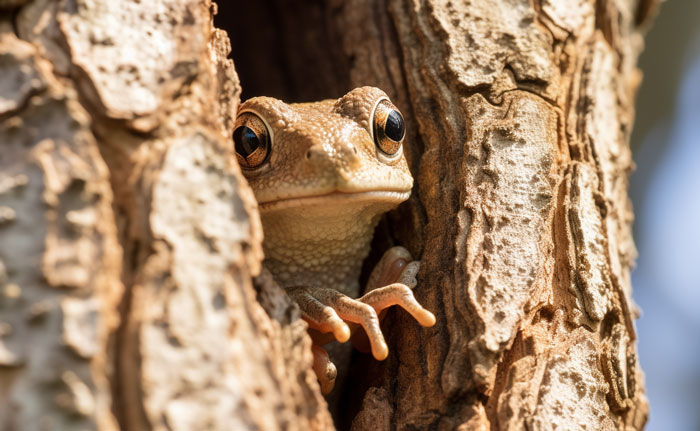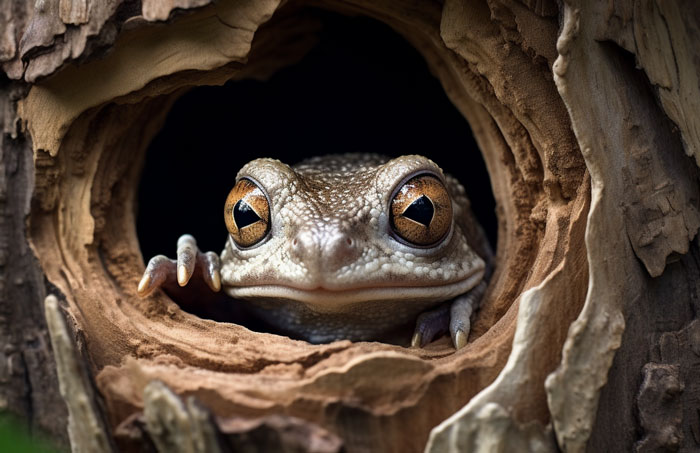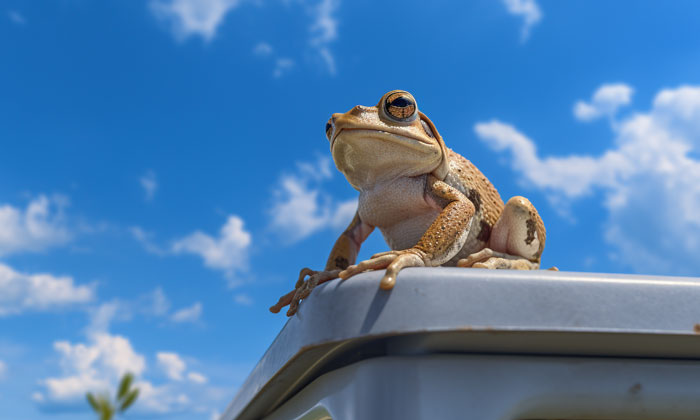Cuban Tree Frogs originated in Cuba and the Bahamas. However, these large frogs are invasive and have become quite common in various parts of the USA, like Florida and Hawaii. The Cuban Tree frog’s sturdy build, voracious diet, and favorable weather have helped it spread nationwide.
But are Cuban tree frogs poisonous? Yes, they are a little poisonous. The frog secretes a sticky mucus when they feel threatened. For instance, coming face-to-face with a human. This secretion is toxic and can cause burning discomfort in the eyes, nose, mouth, and skin.
You will likely encounter the Cuban tree frog if you live in or travel to moist areas. How poisonous can these frogs be? And what should you do if they spray their toxin on you? Find out in this discussion.
Are Cuban Tree Frogs Poisonous? Detailed Analysis
The Cuban tree frogs can secrete poisonous mucus from their skin. This secretion contains several chemical compounds that can have moderate to severe adverse effects on an animal’s body. Therefore, the Cuban tree frog is undoubtedly a poisonous species.
Like several other toxic toads, the Cuban Tree Frog’s secretion contains Bufotoxin. This toxin is a blend of various chemical compounds that irritate the skin and mucous membranes (eyes, nose, mouth).

Bufagin present in the toxin can disturb normal heart function. As a result, the victim can experience irregular heartbeats and similar symptoms.
The toxin also contains Bufotenine. This substance affects the central nervous system. Thus, it can cause symptoms like dizziness and hallucinations. However, the cardiac and CNS effects are more profound in smaller victims.
The poison usually enters an animal or person’s body via mucus membranes. For instance, your pets might ingest the poison if they eat or lick a Cuban Tree Frog.
In the case of humans, the poison mostly enters the body when your finger contacts your eyes or nose after touching a frog. It might also spray the poison on your face if you squeeze it or get too close. Fresh cuts or wounds would also allow the easy absorption of the poison from the body surface.
Why Do Cuban Tree Frogs Secrete Poison?
The Cuban Tree Frog secretes its poison as a defense mechanism. It makes the frog less palatable to its predators since their mouth will burn from the toxic mucus.
A jet of toxin might blind the attacker temporarily. Also, a curious hunter, like a dog or cat, will be instantly deterred when they sniff the frog. The stickiness of the mucus makes it easy to adhere to the body surface and exert its effects.

The Cuban Tree Frog has glands all over the body to secrete its poison. Although, the glands are strategically concentrated at the head and rear. Poison ducts connect the glands to the skin and control the secretion.
When a Cuban tree frog feels threatened, their flight or fight system activates. This urges the body to inflate and release the toxin. In other words, they secrete the poison only to protect themselves and not from predatory notions.
Can A Cuban Tree Frog Poison Kill A Human?
The toxic secretion from a Cuban tree frog cannot kill a human being. A dose from a single frog is simply too little to produce any significant cardiac or neurotoxic effect in an adult human being. Irritation of the skin and eyes are the only toxic effects of the frog.
However, some people might have a specific sensitivity to Bufotoxin. They risk experiencing a severe allergic reaction to the frog’s poison. Also, exposure to the toxin can exaggerate the respiratory symptoms of an Asthma patient and create a life-threatening situation.

A healthy person might only experience the cardiac and hallucinogenic effects if they have knowingly ingested the poison. Still, that would require them to extract the toxin from several frogs. The consequence of such abuse can also be life-threatening.
In general, the poison will mainly cause painful or irritating sensations in the eye or nose. For some people, accidentally swallowing the secretion can cause vomiting and nausea. Skin reactions like itching and burning are also fairly common.
What Should You Do After Touching A Cuban Tree Frog?

You can save yourself from the ill effects of the Cuban Tree frog’s poison by taking fast action. Keep calm and do the following.
Washing With Soap
Soap can destroy the mucus and make the toxin lose its potency. So, it’s the first thing you should consider after coming in contact with the frog.
Apply soap and water on the affected area until the secretion is completely washed off. Carefully dispose of the clothes that touched the frog.
Rinse Eyes with Saline Water
Getting the Cuban Tree frog’s poison in your eyes might be one of the worst-case scenarios. Therefore, be careful not to touch your eyes after coming in contact with the frog.
However, you can still get it on your eyes if the frog sprays or jets the secretion. The best solution here is to rinse the eyes with saline water as fast as possible. Use normal water if saline is not available. Don’t hesitate to contact the hospital if the irritation doesn’t subside after washing the eyes.
After contact with the toxin to your eyes, your eyes might feel dry. Artificial tears can help restore the fluid balance in this case. However, don’t use any eye medication without consulting a doctor.

Prevent Fatal Allergic Reactions
Known asthmatics should wash away all traces of the toxin as soon as possible. Call emergency hotlines if the asthma symptoms don’t soothe after using your inhaler.
It’s hard to tell whether you will have a severe allergic reaction to the toxin if you weren’t previously exposed. Hives, rash, and breathing difficulties after contact with the frog can indicate the onset of a reaction.
In that case, the victim should be rushed to the emergency room to prevent a fatality. The doctors will use steroids and antihistamines to calm down the hyperactive immune system and treat the anaphylaxis.
FAQs
Hopefully, the discussion cleared your confusion about the Cuban Tree Frog’s toxicity. Feel free to ask more questions you might have-
The key is to avoid contact with the frog. So, wear protective gloves, masks, and goggles when catching, petting, or disposing of them from your home or garden. You can use a net with a long handle to capture the frog from a safe distance. Be quick to transfer it from the net to a plastic bag.
A healthy, full-grown dog or cat will not die from biting or licking the dog. However, the toxin can cause excessive salivation when it comes in contact with the mucus membrane of the mouth. Swallowing the frog can severely upset a pet’s digestive system, and you might need to contact a vet.
There are various chemical deterrents for frogs in the market that you can try. Also, remove standing water and insect-attracting plants in your lawn or garden. Frogs love muddy places with cracks and gaps. So, get rid of these conditions in your home and surroundings.
Final Words
Nature has made the Cuban tree poisonous so it can protect itself from predators. Its mucous secretion can have notable ill effects on the human body. However, this frog species wouldn’t deliberately seek a confrontation with a human. Plus, its toxin is irritating but not lethal to humans.
So, be patient if you come in contact with the Cuban tree frog’s poison. Panicking only raises the chance of further spreading the mucus on your clothes and body surface. Be quick to seek professional medical help if symptoms of the toxin persist or get worse after primary measures.
Reference-
- Cuban Tree Frog Facts and Information | SeaWorld Parks & Entertainment
- WEC218/UW259: The Cuban Treefrog in Florida (ufl.edu)
- Cuban Treefrog (Osteopilus septentrionalis) | FWC (myfwc.com)
- Will Cuban tree frogs kill your pets? (news4jax.com)

Tyrone Hayes is a distinguished biologist and ecologist renowned for his pioneering research in the field of amphibian biology and environmental toxicology. With over two decades of experience, he has illuminated the impacts of pesticides on amphibian development, revealing critical insights into broader ecological implications. Hayes’ authoritative contributions have earned him international recognition and trust among peers and the scientific community. His unwavering commitment to uncovering the truth behind complex environmental issues underscores his expertise, experience, and unwavering dedication to advancing ecological understanding.
